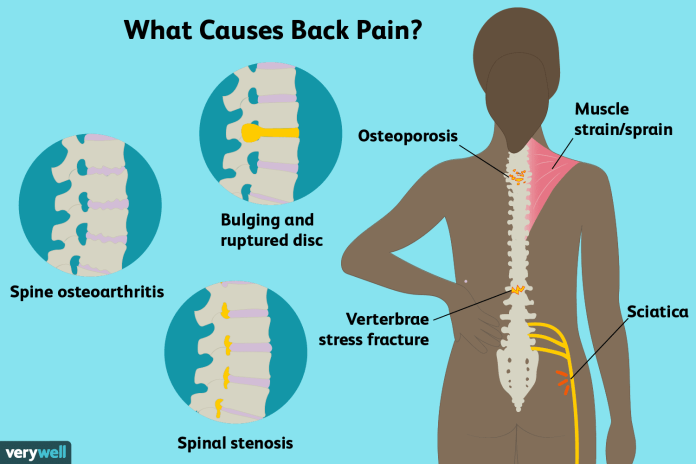Estimated reading time: 0 minutes
There are numerous underlying causes of back stiffness, and having a brief list of possible causes will help you have a more productive conversation with your doctor.
Here are four common root causes of back rigidity and pain:
1. Quadriceps and hip muscle tension
Certain muscle groups in your thighs and/or hips may influence the biomechanics of your spine if they are tight.
Several examples include:
Hamstring pull
The hamstrings extend down the rear of the thighs. Numerous factors, including physical inactivity and/or a failure to extend before and/or after exercise, can cause these enormous and powerful muscles to contract.
When you contract your hamstrings, they shorten. These modifications may affect the curvature of your lower back, causing it to be misaligned with your pelvis (hip). Consequently, you may experience rigidity in your lower back, with or without pain. Typically, the stiffness is more noticeable when the vertebrae is bent forward.
Targeted hamstring stretching can help you progressively lengthen your hamstrings while also relieving tightness in the lower back.
Hip flexors that are excessively tight
The iliopsoas muscle in your hip enables you to lift your thigh and bring it near to your body. This movement is known as hip abduction.
The segments of the vertebrae can become rigid due to tightness in the iliopsoas muscle. Spinal instability can result from excessive iliopsoas tension. Additionally, the adjacent spinal tissues may become inflamed and irritated, causing pain.
Hip flexor lengthening stretches can alleviate pressure on the spine.
2. The position of sitting with the vertebrae curved forward.
When seated for an extended period of time, the vertebrae undergoes the following changes:
Each spinal segment is subject to a rise in pressure.
decreased muscle strength in your upper and lower spine
nutrient deficiency in spinal tissues
When you sit on the edge of your chair or lean over your computer, you increase the tension on your spine, which can lead to stiffness and discomfort.
These alterations can be exacerbated by sedentism, resulting in spinal stiffness within an hour of seating.
Maintain a seated position that is upright to prevent back stiffness. Shoulders rolled back, ears on top of shoulders, upper limbs parallel to the torso. Avoid relying solely on the backrest of your office chair and maintain an upright posture to engage your abdominal muscles.
3. Alterations in the inflammation of your vertebrae
Inflammation can cause the joints of your spine to stiffen and/or fuse, leading to rigidity. Here are two frequent instances:
Ankylosing spondylitis
Ankylosing spondylitis occurs when spinal inflammation leads to progressive vertebral fusion. This syndrome produces upper and/or lower back pain and/or stiffness.
Typically, the stiffness improves with activity but not with relaxation.
Osteoarthritis
Osteoarthritis is the deterioration of the protective cartilage between the facet joints at the back of your spine. As a result, when you move, your joints generate additional friction, causing pain and rigidity.
The rigidity frequently manifests in the morning, improves with movement throughout the day, and returns after extended periods of inactivity or rest.
Ankylosing spondylitis and spinal osteoarthritis may be treated with medication, exercise, and adjustments in lifestyle.
4. Dehydration and diminution of the spinal disc
The intervertebral discs are shock-absorbing cushions that rest between your vertebrae and distribute loads along the spine. These discs may degenerate due to age-related alterations, thereby influencing their biomechanics.
When a disc degenerates, its fibrocartilage component deteriorates, it loses water, and its height diminishes. These modifications may cause spinal stiffness, especially when stooping. 7
Common treatments include physical therapy, exercise, medications, and (if applicable) weight loss. Surgery is only recommended in uncommon instances.
Consult your physician if back stiffness persists despite self-care and/or interferes with your normal activities. A physician can help you determine the cause of your back stiffness and devise a treatment plan for the underlying cause.
Related-
Know more about Ayurvedic Spinal Disk & Radiculopathy Treatments.
GET IN TOUCH


Recent comments